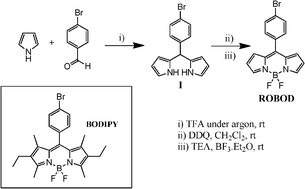Fluorescent molecular rotors under pressure: synergistic effects of an inert polymer†
Abstract
Sterically unhindered boron dipyrromethene

* Corresponding authors
a
Molecular Photonics Laboratory, School of Chemistry, Bedson Building, Newcastle University, Newcastle upon Tyne, NE1 7RU, United Kingdom
E-mail:
anthony.harriman@ncl.ac.uk
Fax: 44 191222 8660
Tel: 44 191222 8660
b Laboratoire de Chimie Moléculaire et Spectroscopies Avancées (LCOSA), UMR 7515 au CNRS, Ecole Européenne de Chimie, Polymères et Matériaux, 25 rue Becquerel, Strasbourg Cedex 02, France
Sterically unhindered boron dipyrromethene

 Please wait while we load your content...
Something went wrong. Try again?
Please wait while we load your content...
Something went wrong. Try again?
M. A. H. Alamiry, E. Bahaidarah, A. Harriman, T. Bura and R. Ziessel, RSC Adv., 2012, 2, 9851 DOI: 10.1039/C2RA20786A
To request permission to reproduce material from this article, please go to the Copyright Clearance Center request page.
If you are an author contributing to an RSC publication, you do not need to request permission provided correct acknowledgement is given.
If you are the author of this article, you do not need to request permission to reproduce figures and diagrams provided correct acknowledgement is given. If you want to reproduce the whole article in a third-party publication (excluding your thesis/dissertation for which permission is not required) please go to the Copyright Clearance Center request page.
Read more about how to correctly acknowledge RSC content.
 Fetching data from CrossRef.
Fetching data from CrossRef.
This may take some time to load.
Loading related content
